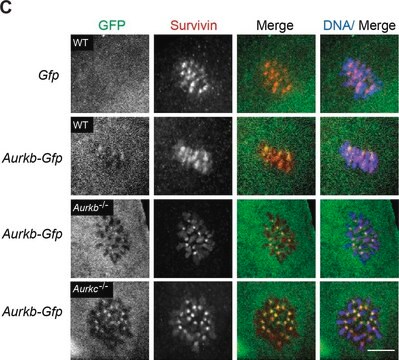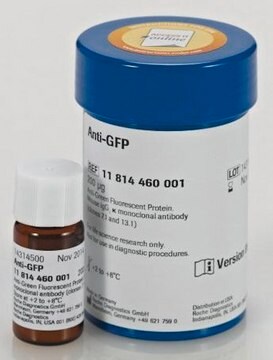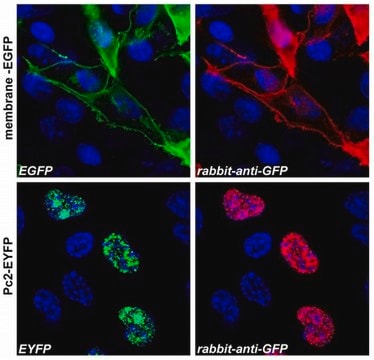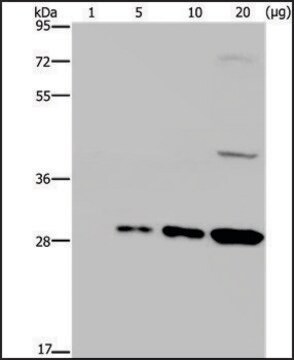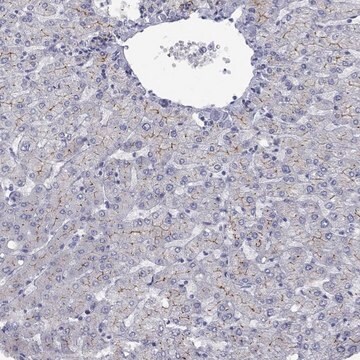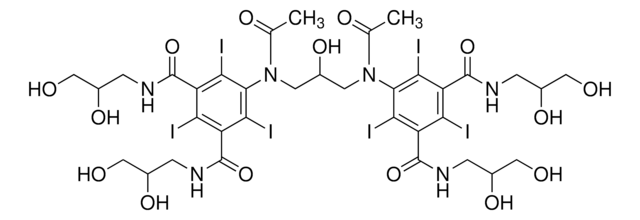MABE1906
Anti-Venus (YFP) Antibody, clone 5
clone 5
Synonym(e):
GFP(YFP), GFP(F46L)
Anmeldenzur Ansicht organisationsspezifischer und vertraglich vereinbarter Preise
Alle Fotos(1)
About This Item
UNSPSC-Code:
12352203
NACRES:
NA.41
Empfohlene Produkte
Allgemeine Beschreibung
Green fluorescent protein (UniProt: P42212; also known as GFP) is encoded by the GFP gene in Aequorea victoria (Jelly Fish). GFP is a 27 kDa protein from jellyfish that serves as an energy-transfer acceptor. It transduces the blue chemiluminescence of the protein aequorin into green fluorescent light by energy transfer and it fluoresces in vivo upon receiving energy from the Ca2+-activated photoprotein aequorin. GFP has an absorption max at 395 nm and the emission peaks at 507 to 510 nm. However, the exact value of emission max depends on the environment of the chromophore. GFP has evolved into an important tool in cell biology research that displays stability under fixation conditions and is suitable for a variety of applications. Venus is a genetic mutant with F46L substitution in green fluorescent protein (GFP), derived from Aequorea victoria. Its excitation/emission peaks are 515/528 nm respectively and is often used as a donor-acceptor pair by researchers in FRET based co-localization studies. Compared to other fluorescent tags, Venus provides higher expression levels and better yields in preparative purifications. A fusion protein consisting of Venus and a defective mutant of p27 protein (p27K ) has been used to identify and isolate a population of quiescent cells and visualize the G0 to G1 transition. Clone 5 specifically detects only the Venus-tagged proteins. (Ref.: Nagai, T., et al. (2002). Nat. Biotechnol. 20(1); 87-90; Oki, T., et al. (2014). Sci. Rep. 4; Article 4012; Rana, MS., et al. (2018). Biochemistry 57(49); 6741-6751).
Spezifität
Clone 5 is a mouse monoclonal antibody that detects proteins labeled with Venus (YFP). It does not display cross-reactivity with mCherry, mRuby, or mClover.
Immunogen
GST‐tagged full-length mVenus, a genetic mutant of GFP derived from Aequorea Victoria (Jelly fish).
Anwendung
Immunocytochemistry Analysis: A 1:500 dilution from a representative lot detected Venus (YFP) in NIH3T3 (L20V-9-11) cells (Courtesy of Li Ten and Kensaku Murano, Ph.D., Keio University School of Medicine, Tokyo Japan).
Western Blotting Analysis: A 1:250 dilution from a representative lot detected Venus (YFP) in HEK293T cells transfected with mVenus that was expressed using pCAGGS-Myc eukaryotic expression plasmid (Courtesy of Li Ten and Kensaku Murano, Ph.D., Keio University School of Medicine, Tokyo Japan).
Immunoprecipitation Analysis: A 1:1,000 dilution from a representative lot immunoprecipitated Venus (YFP) labeled proteins in pCAGGS-myc (negative) and pCAGGS-myc-mVenus (positive) HEK293T cell lysates (Courtesy of Li Ten and Kensaku Murano, Ph.D., Keio University School of Medicine, Tokyo Japan).
Western Blotting Analysis: A 1:250 dilution from a representative lot detected Venus (YFP) in HEK293T cells transfected with mVenus that was expressed using pCAGGS-Myc eukaryotic expression plasmid (Courtesy of Li Ten and Kensaku Murano, Ph.D., Keio University School of Medicine, Tokyo Japan).
Immunoprecipitation Analysis: A 1:1,000 dilution from a representative lot immunoprecipitated Venus (YFP) labeled proteins in pCAGGS-myc (negative) and pCAGGS-myc-mVenus (positive) HEK293T cell lysates (Courtesy of Li Ten and Kensaku Murano, Ph.D., Keio University School of Medicine, Tokyo Japan).
Qualität
Isotype testing: Identity Confirmation by Isotyping Test. Isotyping Analysis: The identity of this monoclonal antibody is confirmed by isotyping test to be mouse IgG1.
Zielbeschreibung
~35 kDa observed; 26.88 kDa calculated for GFP. Uncharacterized bands may be observed in some lysate(s).
Physikalische Form
Protein G purified
Purified mouse monoclonal antibody IgG1 in buffer containing 0.1 M Tris-Glycine (pH 7.4), 150 mM NaCl with 0.05% sodium azide.
Rekonstituierung
0.5 mg/mL. Please refer to guidance on suggested starting dilutions and/or titers per application and sample type.
Lagerung und Haltbarkeit
Stable for 1 year at +2°C to +8°C from date of receipt.
Sonstige Hinweise
Species Reactivity Note: Aequorea victoria. Predicted to react with all species.
Haftungsausschluss
Unless otherwise stated in our catalog or other company documentation accompanying the product(s), our products are intended for research use only and are not to be used for any other purpose, which includes but is not limited to, unauthorized commercial uses, in vitro diagnostic uses, ex vivo or in vivo therapeutic uses or any type of consumption or application to humans or animals.
Lagerklassenschlüssel
12 - Non Combustible Liquids
WGK
WGK 1
Flammpunkt (°F)
Not applicable
Flammpunkt (°C)
Not applicable
Analysenzertifikate (COA)
Suchen Sie nach Analysenzertifikate (COA), indem Sie die Lot-/Chargennummer des Produkts eingeben. Lot- und Chargennummern sind auf dem Produktetikett hinter den Wörtern ‘Lot’ oder ‘Batch’ (Lot oder Charge) zu finden.
Besitzen Sie dieses Produkt bereits?
In der Dokumentenbibliothek finden Sie die Dokumentation zu den Produkten, die Sie kürzlich erworben haben.
Unser Team von Wissenschaftlern verfügt über Erfahrung in allen Forschungsbereichen einschließlich Life Science, Materialwissenschaften, chemischer Synthese, Chromatographie, Analytik und vielen mehr..
Setzen Sie sich mit dem technischen Dienst in Verbindung.